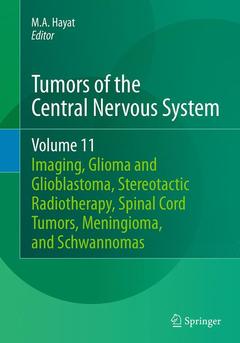Description
Tumors of the Central Nervous System, Volume 11, Softcover reprint of the original 1st ed. 2014
Pineal, Pituitary, and Spinal Tumors
Tumors of the Central Nervous System Series, Vol. 11
Coordinator: Hayat M.A.
Language: English
Subject for Tumors of the Central Nervous System, Volume 11:
Keywords
Publication date: 08-2016
Support: Print on demand
Publication date: 09-2013
371 p. · 17.8x25.4 cm · Hardback
Description
/li>Contents
/li>Comment
/li>
Preface. I Imaging.- An introduction to brain tumor imaging.-Molecular imaging of brain tumors.- Use of 11c-4dst-pet for imaging of human brain tumors. II Glioma and glioblastoma.- Diffusion tensor magnetic resonance imaging-based tractography for glioma surgery.- Angiocentric glioma, pilomyxoid astrocytoma, and Pituicytoma: new entities in the world health organization classification.- Diffuse intrinsic pontine gliomas in children: treatment (an Update).- Gliomatosis cerebri: implications of genetic findings.- Impact of bevacizumab chemotherapy on glioblastomas.- Glioblastoma microvesicles transport rna and proteins Promoting tumor growth.- Microrna in the pathophysiology of glioblastoma.- Surgical management of incidental low-grade gliomas. III Stereotactic radiosurgery.- Stereotactic radiosurgery for the treatment of brain metastases.- Local control of low-volume brain metastases using stereotactic radiosurgery.- Tumor seeding after stereotactic brain biopsy.- Intracranial stereotactic radiosurgery in high risk patients with metastases from radioresistant primary tumors.- Brain metastases: treatment with stereotactic iodine-125 brachytherapy.- Stereotactic radiosurgery for skull base meningiomas. IV Spinal cord tumors.- Pediatric spinal cord tumors.- Radiosurgery for intramedullary spinal cord tumors.- Novalis spinal radiosurgery.- Etiology and outcomes of pediatric spinal cord tumors. V Meningioma.- Selection of elderly meningioma patients for surgery using a Clinical-radiological grading system as a predictor of outcome.- Cranial meningioma in neurofibromatosis type 2 patients: role of mutations.- Classification of meningioma using immunogenic antigens.- Treatment of benign meningiomas using radiosurgery.- Necrotic rhabdoid meningiomas: histopathological diagnosis. VI Schwannomas. 27 Multiple schwannomas: diagnosis and treatment.- Treatment of patients with vestibular schwanommasusing gamma knife radiosurgery.- Schwannomas in the craniocervical region: complete surgical removal.- Cranial base surgery of hypoglossal schwannomas. Index.




